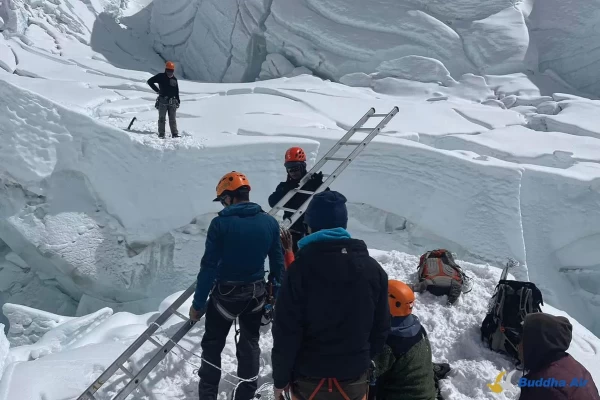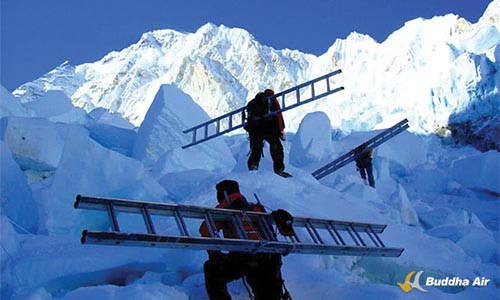The Icefall Doctors: Unsung Heroes in the Himalayas

The icefall doctor isn’t a medical expert, but rather an expert of the mountains who ensure the safety of climbers and mountain guides on Everest.
Mount Everest, the world’s tallest peak at 8,849 meters, is a global aspiration for climbers. However, the pursuit of records has turned into a costly and fiercely competitive modern-day race, overshadowing the camaraderie and respect for nature that once characterized mountaineering. The commercialization of Everest expeditions has drawn adventurers of all skill levels, leading to unhealthy rivalry.
Since 1953 it is recorded 6,664 individuals have successfully climbed the peak, but 317 lives have been lost in attempts between 1921 and 2023.
Every spring, hundreds of climbers flock to Nepal to conquer Mount Everest, their ultimate dream. Yet, few recognize the unsung heroes, the Icefall Doctors, who silently brave dangers to ensure climbers’ safety and enable their remarkable achievements.
Icefall Doctors are skilled Sherpas on Mount Everest responsible for preparing and maintaining a safe passage through the Khumbu Icefall, considered the most dangerous route on Everest and Lhotse ascent.
They handle rope fixing, icefall monitoring, and rescues from base camp to camp two, using technical climbing and navigation skills to create a secure route. They assess conditions, manage instability, and respond to accidents amid various risks, including avalanches, icefalls, crevasses, altitude sickness, extreme cold, high winds, and harsh weather.
Mingma Temba Sherpa (ICEFALL DOCTOR)
Mingma Temba Sherpa, 29, an Icefall doctor hails from Khumbu Pasang Lhamu Municipality - 3, Solukhumbu District.
Establishing the route from base camp 5,364 m (17,598 ft) to camp II 6,400m (20,997 ft) is a perilous task, it is considered the most challenging route to Everest. The role of icefall doctors spans three months, concluding once the final Everest expedition reaches the summit.
Mingma began his career in the field at a young age of 19 in 2016. Before entering the field, he pursued lama education for 7-8 years and learnt Tibetan script. Due to the immense risks involved in high-altitude mountain work, his family initially hesitated to send him into the mountains. “There’s a lot of risk and hard work,” he acknowledges. “But I had to take up the job to support my family.”
He recalled taking up the job which was accompanied by friends who shared common interests. Mingma, along with friends, took 15-day ice climbing training at Khumbu Climbing Center. He learned fundamental climbing skills, including proper use of gear, safety protocols, and ice conditions assessment. He also practiced safe belaying and rappelling, knot tying, anchor building, and route finding and navigation skills. The course provided him with the knowledge and confidence to safely enjoy ice climbing.
Each year, the Sagarmatha Pollution Control Committee (SPCC) selects the Icefall doctors team members prior to commencement for the Everest expedition, starting in March. Their primary role is to scout routes, install ladders and ropes, and ensure the maintenance of the expedition route through the challenging treacherous Khumbu Icefall, a challenging stretch along the Everest climbing route.

Icefall doctors, led by a team leader, consist of an 8-member team tasked with ensuring the safety of the Everest expedition route. They conduct inspections and monitor the route, particularly focusing on the dangerous areas below camp 2 due to various risks. The journey begins with Puja ceremonies at Namche, Pangboche, and Tengboche to seek blessings and ensure safety. The team also clears and repairs trail routes covered in snow. At base camp, a Lapsu Puja ceremony is conducted, and prayer flags are installed. Tasks are divided among team members, who utilize various equipment for route opening.
As they commence opening the route, two individuals move ahead, equipped with belaying gear and anchor-setting equipment. Several ice climbing equipment such as ropes, ice screws, snow bars, carabiners, and ice tools are utilized, in addition to personal gear including helmets, harnesses, boots, crampons, radio sets, sunglasses, gloves, climbing boots, sleeping bags, tents, and medical supplies. Mingma reflects on his initial excitement turning into fear as he gained more knowledge about the mountains.
He shares, “At first, it didn’t seem like a difficult job. But after becoming familiar with the route, fear set in.”
According to Mingma icefall doctors are often misunderstood as medical professionals in Nepal, with western climbers showing respect and recognition for their expertise.
2023 Avalanche Incident: A Fortunate Escape
Last year’s spring Everest expedition in 2023 witnessed a sudden rockfall below camp-I, causing avalanches to strike. Despite being aware of the risks, Icefall doctors proceeded through the area, resulting in one of their colleagues being injured. This incident remains one of Mingma’s closest encounters with death and a fortunate escape.
Reaching Camp II successfully marks the pinnacle of achievement for icefall doctors, a moment of immense joy and satisfaction. Despite enduring a month of arduous work in the treacherous mountains, the challenges fade into insignificance. With the route successfully opened, their manager relays the message to Basecamp (SPCC). However, their responsibilities are far from over. They must continuously monitor and repair the route for three months until the expedition concludes in the last week of May.
They have to wait until all Everest expeditions conclude their summit journeys before they can begin the task of dismantling the equipment they had installed. With hundreds of climbers and crew members traversing the route, it undergoes significant wear and tear. Undoing and removing all the equipment typically takes a couple of days or more.
Following the conclusion of their three-month-long high-altitude duties, they celebrate upon returning to Namche. This typically occurs around May 29th, marking the culmination of their efforts and the successful completion of another Everest expedition.
Despite the inherent dangers, icefall doctors earn between 6 to 7 lakhs in a season, with insurance coverage ranging from 15 to 20 lakhs per person. According to Mingma, a slightly higher earning would ensure a better life for icefall doctors, enabling them to adequately support their families and provide education for their children.
After the main Everest expedition is over, Minga spends the rest of the year climbing smaller peaks, farming in the village and attending training and refresher courses in Kathmandu. He has also climbed Ama Dablam and Island peak three times each, and Mera Peak twice.
With seven years of experience in the field, Mingma brings a wealth of expertise and dedication to his role.
He resides in Kapan, on the outskirts of Kathmandu, with his wife Tashi Sherpa and their 30-month-old son, Tenzing Kunkyap Sherpa.
Throughout his seven-year career in the mountains, he has reached Camp II in the Everest region multiple times as an Icefall doctor, yet didn’t summit Everest top. Despite occasional fatigue from his mountain work, he holds a deep-seated desire to reach the pinnacle of Everest, stating, “I aspire to stand on the top at least once in my lifetime.”
